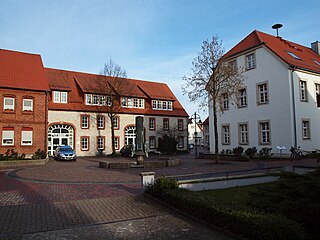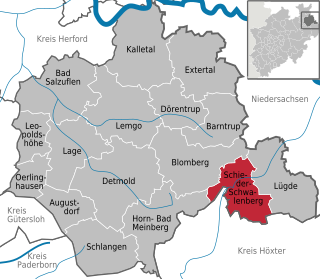
Westphalia is a region of northwestern Germany and one of the three historic parts of the state of North Rhine-Westphalia. It has an area of 20,210 square kilometres (7,800 sq mi) and 7.9 million inhabitants.

Detmold is one of the five Regierungsbezirke of North Rhine-Westphalia, Germany, located in the north-east of the state. It is congruent with region of Ostwestfalen-Lippe.

Detmold is a city in North Rhine-Westphalia, Germany, with a population of 73,969. It was the capital of the small Principality of Lippe from 1468 until 1918 and then of the Free State of Lippe until 1947. Today it is the administrative center of the district of Lippe and of the Regierungsbezirk Detmold. The Church of Lippe has its central administration located in Detmold. The Reformed Redeemer Church is the preaching venue of the state superintendent of the Lippe church.

Lemgo is a University and Old Hanseatic town in the Lippe district of North Rhine-Westphalia, Germany.

Augustdorf is a municipality in the Lippe district of North Rhine-Westphalia, Germany. It has an area of 42.18 km2 and about 10,100 inhabitants (2020).

Extertal is a municipality in the Lippe district of North Rhine-Westphalia, Germany, with c. 11,500 inhabitants (2013).

Schlangen is a municipality in the Lippe district of North Rhine-Westphalia, Germany. Schlangen has about 9.000 inhabitants (2013) and enjoys relative prosperity. Located a few kilometers away from Detmold, the municipality stretches from the edge of the sandy Sea to the mountain course of the Teutoburger forest southern slope.

Bad Salzuflen is a town and thermal spa resort in the Lippe district of North Rhine-Westphalia, Germany. At the end of 2013, it had 52,121 inhabitants.

Oerlinghausen is a city in the Lippe district of North Rhine-Westphalia, Germany located between Bielefeld and Detmold in the Teutoburg Forest. At the end of February 2023, it had 17,314 inhabitants.

Brüggen is a municipality in the district of Viersen, in North Rhine-Westphalia, Germany. It is situated near the border with the Netherlands, on the river Schwalm, approx. 15 km south of Venlo and 20 km north-west of Mönchengladbach.

Raesfeld is a municipality in the district of Borken in the state of North Rhine-Westphalia, Germany. It is located approximately 10 km south of Borken and 30 km east of the Dutch border.

Bedburg-Hau is a municipality in the district of Kleve in the state of North Rhine-Westphalia, Germany. It is located approximately 5 km south-east of Kleve.

Schieder-Schwalenberg is a town in the Lippe district, in North Rhine-Westphalia, Germany. It is situated approximately 20 km (12 mi) east of Detmold.

Bad Laasphe is a town in North Rhine-Westphalia, Germany, in the Siegen-Wittgenstein district.

Lippe was a state in Germany, ruled by the House of Lippe. It was located between the Weser river and the southeast part of the Teutoburg Forest. It originated as a state during the Holy Roman Empire, and was promoted to the status of principality in 1789. During this period the ruling house split into a number of branches, with the main line residing at Detmold. During the Reformation, Lippe had converted to Lutheranism in 1538 and then to Calvinism in 1604.

The House of Lippe is the former reigning house of a number of small German states, two of which existed until the German Revolution of 1918–19, the Principality of Lippe and the Principality of Schaumburg-Lippe.

Weser Renaissance is a form of Northern Renaissance architectural style that is found in the area around the River Weser in central Germany and which has been well preserved in the towns and cities of the region.

Frederick Adolphus of Lippe-Detmold was a German nobleman and the Count of Lippe-Detmold from 1697 to 1718.

Emil Zeiß was a German Protestant minister and painter. His body of work includes 33 sketchbooks and 1092 identified individual works, largely donated by his son to the Lippe Museum.

Detmold Station is the main train station of the city of Detmold in the German state of North Rhine-Westphalia. It was opened in 1880. It is classified by Deutsche Bahn as a category 5 station, and has two platform tracks. The station building was thoroughly renovated in 2006 and 2007.


























